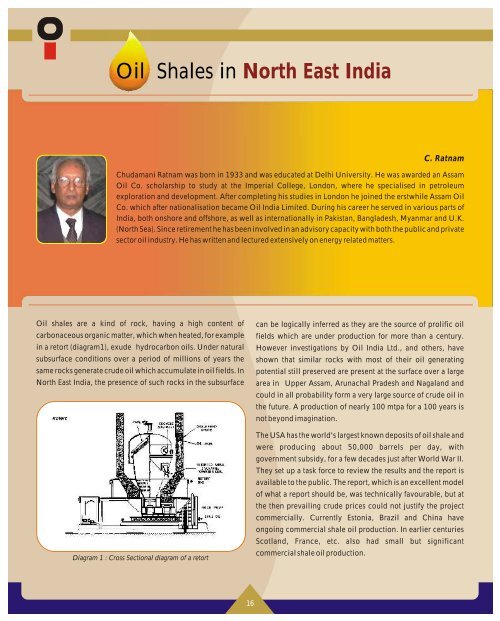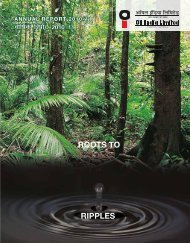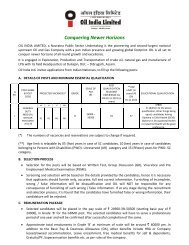2006 - Oil India Limited
2006 - Oil India Limited
2006 - Oil India Limited
You also want an ePaper? Increase the reach of your titles
YUMPU automatically turns print PDFs into web optimized ePapers that Google loves.
<strong>Oil</strong> Shales in North East <strong>India</strong><br />
C. Ratnam<br />
Chudamani Ratnam was born in 1933 and was educated at Delhi University. He was awarded an Assam<br />
<strong>Oil</strong> Co. scholarship to study at the Imperial College, London, where he specialised in petroleum<br />
exploration and development. After completing his studies in London he joined the erstwhile Assam <strong>Oil</strong><br />
Co. which after nationalisation became <strong>Oil</strong> <strong>India</strong> <strong>Limited</strong>. During his career he served in various parts of<br />
<strong>India</strong>, both onshore and offshore, as well as internationally in Pakistan, Bangladesh, Myanmar and U.K.<br />
(North Sea). Since retirement he has been involved in an advisory capacity with both the public and private<br />
sector oil industry. He has written and lectured extensively on energy related matters.<br />
<strong>Oil</strong> shales are a kind of rock, having a high content of<br />
carbonaceous organic matter, which when heated, for example<br />
in a retort (diagram1), exude hydrocarbon oils. Under natural<br />
subsurface conditions over a period of millions of years the<br />
same rocks generate crude oil which accumulate in oil fields. In<br />
North East <strong>India</strong>, the presence of such rocks in the subsurface<br />
Diagram 1 : Cross Sectional diagram of a retort<br />
can be logically inferred as they are the source of prolific oil<br />
fields which are under production for more than a century.<br />
However investigations by <strong>Oil</strong> <strong>India</strong> Ltd., and others, have<br />
shown that similar rocks with most of their oil generating<br />
potential still preserved are present at the surface over a large<br />
area in Upper Assam, Arunachal Pradesh and Nagaland and<br />
could in all probability form a very large source of crude oil in<br />
the future. A production of nearly 100 mtpa for a 100 years is<br />
not beyond imagination.<br />
The USA has the world's largest known deposits of oil shale and<br />
were producing about 50,000 barrels per day, with<br />
government subsidy, for a few decades just after World War II.<br />
They set up a task force to review the results and the report is<br />
available to the public. The report, which is an excellent model<br />
of what a report should be, was technically favourable, but at<br />
the then prevailing crude prices could not justify the project<br />
commercially. Currently Estonia, Brazil and China have<br />
ongoing commercial shale oil production. In earlier centuries<br />
Scotland, France, etc. also had small but significant<br />
commercial shale oil production.<br />
16

















